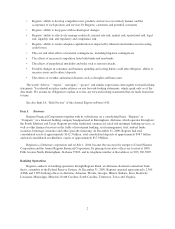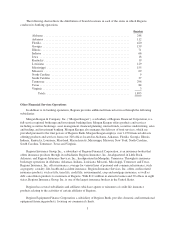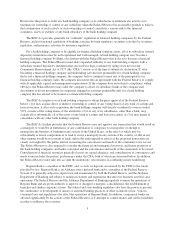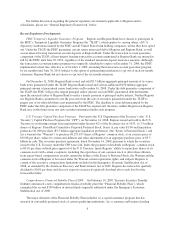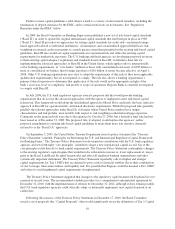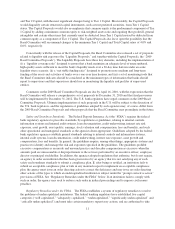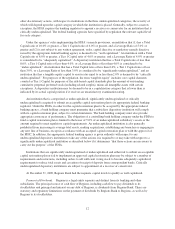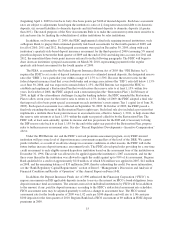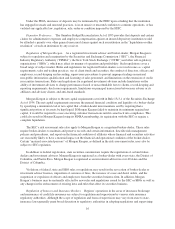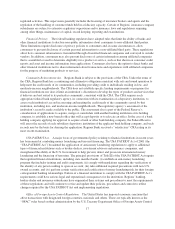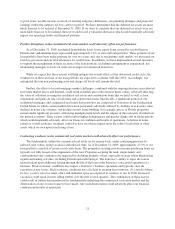Regions Bank 2009 Annual Report Download - page 25
Download and view the complete annual report
Please find page 25 of the 2009 Regions Bank annual report below. You can navigate through the pages in the report by either clicking on the pages listed below, or by using the keyword search tool below to find specific information within the annual report.and Tier 2 Capital, with the most significant changes being to Tier 1 Capital. Most notably, the Capital Proposals
would disqualify certain structured capital instruments, such as trust preferred securities, from Tier 1 Capital
status. The Capital Proposals would also re-emphasize that common equity is the predominant component of Tier
1 Capital by adding a minimum common equity to risk-weighted assets ratio and requiring that goodwill, general
intangibles and certain other items that currently must be deducted from Tier 1 Capital instead be deducted from
common equity as a component of Tier 1 Capital. The Capital Proposals also leave open the possibility that the
Basel Committee will recommend changes to the minimum Tier 1 Capital and Total Capital ratios of 4.0% and
8.0%, respectively.
Concurrently with the release of the Capital Proposals, the Basel Committee also released a set of proposals
related to liquidity risk exposure (the “Liquidity Proposals,” and together with the Capital Proposals, the “2009
Basel Committee Proposals”). The Liquidity Proposals have three key elements, including the implementation of
(i) a “liquidity coverage ratio” designed to ensure that a bank maintains an adequate level of unencumbered,
high-quality assets sufficient to meet the bank’s liquidity needs over a 30-day time horizon under an acute
liquidity stress scenario, (ii) a “net stable funding ratio” designed to promote more medium and long-term
funding of the assets and activities of banks over a one-year time horizon, and (iii) a set of monitoring tools that
the Basel Committee indicates should be considered as the minimum types of information that banks should
report to supervisors and that supervisors should use in monitoring the liquidity risk profiles of supervised
entities.
Comments on the 2009 Basel Committee Proposals are due by April 16, 2010, with the expectation that the
Basel Committee will release a comprehensive set of proposals by December 31, 2010 and that final provisions
will be implemented by December 31, 2012. The U.S. bank regulators have urged comment on the 2009 Basel
Committee Proposals. Ultimate implementation of such proposals in the U.S. will be subject to the discretion of
the U.S. bank regulators, and the regulations or guidelines adopted by such agencies may, of course, differ from
the 2009 Basel Committee Proposals and other proposals that the Basel Committee may promulgate in the future.
Safety and Soundness Standards. The Federal Deposit Insurance Act (the “FDIA”) requires the federal
bank regulatory agencies to prescribe standards, by regulations or guidelines, relating to internal controls,
information systems and internal audit systems, loan documentation, credit underwriting, interest rate risk
exposure, asset growth, asset quality, earnings, stock valuation and compensation, fees and benefits, and such
other operational and managerial standards as the agencies deem appropriate. Guidelines adopted by the federal
bank regulatory agencies establish general standards relating to internal controls and information systems,
internal audit systems, loan documentation, credit underwriting, interest rate exposure, asset growth and
compensation, fees and benefits. In general, the guidelines require, among other things, appropriate systems and
practices to identify and manage the risk and exposures specified in the guidelines. The guidelines prohibit
excessive compensation as an unsafe and unsound practice and describe compensation as excessive when the
amounts paid are unreasonable or disproportionate to the services performed by an executive officer, employee,
director or principal stockholder. In addition, the agencies adopted regulations that authorize, but do not require,
an agency to order an institution that has been given notice by an agency that it is not satisfying any of such
safety and soundness standards to submit a compliance plan. If, after being so notified, an institution fails to
submit an acceptable compliance plan or fails in any material respect to implement an acceptable compliance
plan, the agency must issue an order directing action to correct the deficiency and may issue an order directing
other actions of the types to which an undercapitalized institution is subject under the “prompt corrective action”
provisions of FDIA. See “Regulatory Remedies under the FDIA” below. If an institution fails to comply with
such an order, the agency may seek to enforce such order in judicial proceedings and to impose civil money
penalties.
Regulatory Remedies under the FDIA. The FDIA establishes a system of regulatory remedies to resolve
the problems of undercapitalized institutions. The federal banking regulators have established five capital
categories (“well capitalized,” “adequately capitalized,” “undercapitalized,” “significantly undercapitalized” and
“critically undercapitalized”) and must take certain mandatory supervisory actions, and are authorized to take
11



